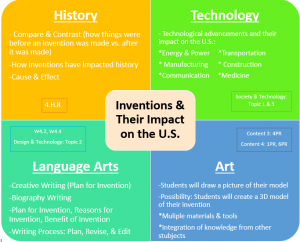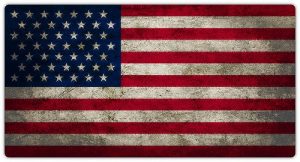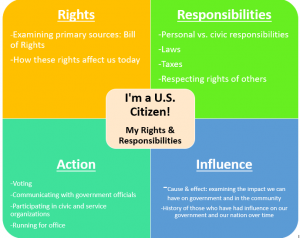Unit #1: Inventions & Their Impact on the U.S.

- Conceptual Lenses: Innovation & Change
- Unit Strands: History, Technology, Geography, Language Arts
- Unit Web: (See Graphic Below)

- History
- Compare & Contrast (how things were before an invention was made vs. after it was made)
- How inventions have impacted history
- Cause & Effect
- Technology
- Technological advancements and their impact on the U.S.:
- Energy & Power
- Transportation
- Manufacturing
- Construction
- Communication
- Medicine
- Technological advancements and their impact on the U.S.:
- Language Arts
- Creative Writing (Plan for Invention)
- Biography Writing
- Plan for Invention, Reasons for Invention, Benefit of Invention
- Writing Process: Plan, Revise, & Edit
- Art
- Students will draw a picture of their model
- Possibility: Students will create a 3D model of their invention
- Multiple materials & tools
- Integration of knowledge from other subjects
- Generalizations:
- Inventions are made to improve our way of life or to solve a particular problem.
- Inventions can improve and evolve over time to meet needs and demands.
- Inventions have improved health care, communication, transportation, etc.
- Inventions can have advantages and disadvantages.
- Creativity is essential to invent something new.
- Guiding Questions:
- Why do inventors invent something new? (C)
- In what ways have inventions improved your life? (C)
- In what ways have inventions improved our nation? (F)
- What factors have contributed the desire for people to invent something new? (F)
- In what ways have inventions improved health care, the way we communicate, transportation, etc? (F)
- Do all inventions improve our way of life? (D)
- How have inventions evolved over time? (F)
- Why is creativity essential to invent something new? (C)
- Critical Content:
- History of inventors and their inventions
- How inventions have benefited Ohio and the U.S.
- Key Skills:
- Explain how technological innovations of inventors from Ohio or that originated in Ohio benefited the United States. (Taken from the Expectations of Learning from the Ohio Learning Standards-4th Grade S.S.)
- Analyzing a text and providing evidence
- Creative writing and the writing process
- Culminating Assessment:
- What: Investigate Ohio inventors and explain how their inventions have benefited Ohio and the U.S.
- Why: …in order to understand that inventions from inventors in Ohio have developed the world we live in today and have improved our way of living in the U.S.
- How: Students will become an Ohio inventor. They will have to devise a well thought out plan for their invention. The prompt will be given to them as followed:
- You are now going to become an Ohio inventor! You are to create a well thought out plan for your invention. In your plan you need to address the following questions.
- What is your invention?
- What does your invention do?
- What materials will you need to create your invention?
- How much will your invention cost for consumers?
- Why is there a need for this invention? What problem does your invention solve?
- How will your invention improve the way of life for others?
- Draw what your invention will look like.
- *If there is time students will be able to create a model (probably not a working model) of their invention.
- *I will also compile all of the students’ invention plans into a book that all the students can read. They will present their pages of the book (with possibly their model) to the class.
- You are now going to become an Ohio inventor! You are to create a well thought out plan for your invention. In your plan you need to address the following questions.
- Learning Experiences: (Links are Underlined, Click to Continue to Website)
- Reader’s theater to start a discussion on Ohio inventors, (Who are some inventors in Ohio? What inventions did they invent? What impact do the inventions have on your life? Why do you think they made these inventions?): Reader’s Theater: Ohio Inventors
- Introduce some inventions to the class using this website (to come after Reader’s Theater) 17 Ohio Inventions and this introduction video
- Students will research inventors and create a biography on one inventor of their choice. They will have to answer factual, conceptual, and debatable questions in their biography. (A guide will be given.)
- Ohio Inventors Biographies
- Famous Female Inventors: 12 Famous Female Inventors & Women Inventors
- Compare & contrast graphic organizer for inventions that have evolved over time
- Cause & effect graphic organizer for a deeper understanding of the impact of an invention
- Introduction to student invention project:
- Unit Overview:
- Think about all of the things you use on a daily basis. For example:the pencil you have on your desk, the glasses some of you are wearing, the bus or car you came to school in, the light switch that turned on the lights when you woke up, etc. Those are all inventions that people just like you invented. In this unit we will explore and learn about many different inventors that include men, women, and even children! We will explore how these inventions benefited Ohio and the U.S. You will have to determine how these inventions have evolved over time and the impact these inventions have had on our society. In the end, you will become inventors and come up with a plan for your invention.
Unit #2: I’m a U.S. Citizen! My Rights & Responsibilities

- Conceptual Lenses: Freedom/Change/Power
- Unit Strands: Rights, Responsibilities, Action, Influence
- Unit Web:

- Rights
- Examining primary sources: Bill of Rights
- How these rights affect us today
- Responsibilities
- Personal vs. civic responsibilities
- Laws
- Taxes
- Respecting rights of others
- Action
- Voting
- Communicating with government officials
- Participating in civic and service organizations
- Running for office
- Influence
- Cause & effect: examining the impact we can have on government and in the community
- History of those who have had influence on our government and our nation over time
- Generalizations:
- U.S. citizens have responsibilities that they must adhere to. If not, there could be consequences.
- U.S. citizens have rights that allows them to have freedoms in the U.S.
- U.S. citizens have the power to influence our government and can change the way things are.
- Throughout history, many people have stood up for what they have believed. People have changed laws and the way our government is run. These events have caused conflict, brought people together, and have shaped how our nation is today.
- A democracy allows for all U.S. citizens (over the age of 18) to vote for who they believe would make the best leader.
- Guiding Questions:
- What rights do all U.S. citizens have? (F)
- What rights do U.S. citizens have that citizens in other countries don’t have? (F)
- What responsibilities do all U.S. citizens have? (F)
- How does voting impact our government and nation? (F)
- Why do some U.S. citizens vote, while others do not? (C)
- Why do people take a stand and try to influence our government? (C)
- How do you will our government change in the future? (D)
- Do you think U.S. citizens’ rights and responsibilities will change in the future? Why or why not? (D)
- Critical Content:
- The responsibilities that U.S. citizens have such as obeying the law and respecting others’ rights
- The freedoms U.S. citizens have such as those covered in the Bill of Rights
- The differences between rights and responsibilities
- The requirements to vote in the U.S. and how voting can impact our government
- People who have influenced our government by taking a stand for what they believed in
- Key Skills:
- Describe the ways citizens participate in and influence their state and national government. ((Taken from the Expectations of Learning from the Ohio Learning Standards-4th Grade S.S.)
- Explain the rights and responsibilities of citizens in a democratic government. (Taken from the Expectations of Learning from the Ohio Learning Standards-4th Grade S.S.)
- Culminating Assessment:
- What: Investigate the rights and responsibilities of U.S. citizens
- Why: …in order to understand that U.S. citizens can participate in and influence our government.
- How: Students will be asked to creatively demonstrate how they could take action in their government/community by either writing a letter to a government official, writing a poem, creating an art piece, writing a petition, starting a fundraiser, or writing a song.
- Learning Experiences: (Links are Underlined, Click to Continue to Website)
- Watch the following YouTube video to start a classroom discussion on the rights and responsibilities of U.S. citizens
- Citizenship Resource Center for information on rights and responsibilities of U.S. citizens. This can be used as content for the unit.
- Use the Bill of Rights to analyze some rights that U.S. citizens have. Students will have to choose which rights they think are the most important and explain why they chose the ones they did. Students will then answer why they believe having all of these rights are crucial to our society.
- Biographies: People who Changed the U.S. Students can use this resource to investigate how people have changed the government throughout history. Have students choose one or more people and have them reflect on how they changed our government, why they changed our government, and the impact they have made on our government today.
- Students will choose one of the conceptual lenses and write a summary of what that conceptual lens means to them after completing the unit.
- Watch this Kid President video to start the students thinking about what they want their final project to be on
- Unit Overview:
- What rights do you have as a U.S. citizen? What responsibilities do you have as a U.S. citizen? Do you know the difference between the two? In this unit, we will be learning about the rights and responsibilities that you and every U.S. citizen has. We will also be determining the difference between the two. We will explore how people have changed our nation and their reasons for doing so. You will also learn about how YOU can make a difference in our government. At the end of the unit, you will have the opportunity to take a stand and change our government and/or community!
